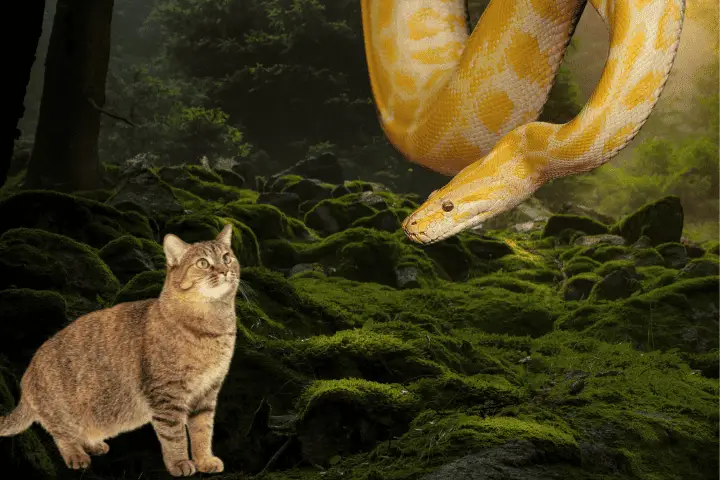Do Snakes Kill Cats
Do snakes kill cats? This captivating question has many pet owners and animal enthusiasts intrigued.
Whilst such cases can occur, they are rare. To comprehend the risks and take precautions, we must understand the relationship between these two creatures.
Snakes have an instinct to hunt prey smaller than them. This includes small kittens or cats who may come across a snake while exploring.
But adult cats can usually protect themselves with their agility and sharp claws.
Certain species of snakes may be more of a threat to cats than others. Venomous snakes, such as rattlesnakes and copperheads, can be fatal if they bite or inject venom.
Non-venomous snakes may still cause fear and anxiety due to their unpredictable behavior.
Background on snakes and cats
Types of venomous snakes commonly found in areas where cats roam
Venomous snakes can be a real danger to cats in certain areas. Let’s explore the types of venomous snakes commonly found in places where cats roam; so you can stay informed and aware.
- Eastern Diamondback Rattlesnake: In the southeastern USA, you can find this snake with its potent venom and diamond-shaped patterns.
- Copperhead: It’s spread across North America and has a copper-colored head and intricate camouflage.
- Western Diamondback Rattlesnake: Native to the southwest, it has a scary rattle on its tail and a dangerous bite.
- Taipan: Mainly in Australia and New Guinea, this is one of the deadliest snakes because of its highly toxic venom and aggressive nature.
- Black Mamba: This snake has a home in sub-Saharan Africa and is known for its deadly speed and venom that can cause paralysis.
These venomous snakes can harm cats as well as humans. So, prevent any potential danger by keeping your cat indoors, or supervising them when they go out.
Typical behaviors of snakes and cats
Snakes and cats have unique behaviors that define their nature. It’s essential to understand them if you want to interact or care for these animals.
Snakes prefer to live alone – they’re more reserved and introverted. Cats, on the other hand, are social and love being around humans and other cats.
Snakes hunt using their keen sense of smell. They strike with lightning speed and precision. Cats also have a natural instinct for hunting, often playing in a way that looks like stalking and pouncing.
Snakes shed their skin regularly and this helps them grow and adapt to their environment.
Snakes and cats have similarities, but also unique characteristics. Ancient Egyptians associated snakes with royalty and divinity.
They even depicted them alongside pharaohs. Cats were also highly regarded in ancient cultures, worshipped for their grace and agility.
Instances of snake attacks on cats
Real-life stories and anecdotes
Snakes and cats don’t always get along. Some cats survive unscathed, but others don’t.
Certain snake species can deliver venomous bites that can be dangerous for cats.
These stories remind us: be careful outside! And if your cat is suspected of being bitten by a snake, get veterinary help fast.
Impact on cat owners and communities
Cat owners and their communities are hugely affected by snake attacks. Implications of these incidents go far beyond the individual cat or its owner.
For owners, the trauma is immeasurable. These cats are often thought of as family members.
Communities feel the impact too. Fear of snakes in gardens or parks makes residents uneasy, affecting their quality of life.
There’s an economic effect, too. Vet bills to treat injured cats can strain resources.
Snakes in residential areas also raise safety concerns for kids and other small animals, increasing community anxiety.
Preventive measures for cat owners
To ensure the safety of your beloved feline companion from potential snake encounters, preventive measures for cat owners must be taken.
By keeping cats indoors to minimize the risk and snake-proofing outdoor spaces for cats, you can effectively mitigate the danger posed by snakes. Let’s dive into these sub-sections for the solutions!
Keeping cats indoors to minimize the risk
Keeping cats inside is a great way to protect them from harm. It reduces their exposure to infectious diseases, curbs accidents, and helps them avoid parasites.
Plus, research shows indoor cats live longer.
To keep cats content indoors, we need to create an enriched environment.
This includes things like scratching posts, interactive playtime with owners, and vertical spaces for climbing and perching.
Plus, access to windows for viewing the outside world.
Making the choice to keep our cats close is essential. It’s up to us to keep them safe and happy.
Snake-proofing outdoor spaces for cats
Snakes can be a problem for cats that wander outdoors. To protect our feline friends, preventive measures must be taken to snake-proof outdoor spaces.
- Inspect the area: Check regularly the places where your cat is outside. Look for any cracks, gaps, or openings that snakes can fit through.
- Secure borders: Make fences stronger by burying the bottom and adding mesh wire or heavy-duty materials on top. Place snake-proof barriers near woodpiles or dense foliage.
- Tidy up: Clear tall grass, brush piles, and debris that snakes can hide in. Keep the environment clean to keep snakes away.
- Use natural repellents: Plant snake-deterring plants like marigolds, lemongrass, or garlic around your cat’s area. These plants smell strong and deter snakes from entering.
- Pet supervision: Watch your cat when they are outside. Regularly check for any signs of snake activity and move your cat to safety if you see one.
Know the snake species in your region. Learn about local snake populations and ask professionals in wildlife management or authorities for help.
Research by The University of Melbourne found that cats tend to stay away from areas with snakes when owners provide safe options nearby.
Snake identification and awareness
Educating cat owners on recognizing venomous snakes
Cat owners need instruction on identifying venomous snakes. Five key tips:
- Teach them to recognize venomous snakes – triangular heads, vertical pupils, heat-sensing pits.
- Show them pics or videos of different species.
- Stress the importance of keeping cats indoors during active seasons.
- Suggest a snake-proof outdoor space with fences and barriers to protect cats and snakes.
- Contact a wildlife removal service if a venomous snake is spotted.
Remember, not all snakes are dangerous. Knowing this can help cats and snakes live in harmony.
Tips for avoiding snake encounters while walking cats outside
Taking cats for outdoor walks can be fun, but precautions must be taken to dodge snake encounters. Tips to keep in mind:
- Be aware of surroundings.
- Use a leash and stay close to cat.
- Stick to well-traveled paths and avoid tall grass and dense vegetation.
During warmer months, snakes seek out sunny spots. So, it’s better to minimize outdoor walks.
By following the tips and understanding the history, we can give cats safe and happy outdoor walks. Stay attentive and keep your furry pal nearby!
Teaching cats to avoid dangerous situations
Watch your cat closely, especially when they explore unfamiliar places or face potential threats. React quickly if danger arises.
Set up barriers or use pet gates to limit your cat’s access to unsafe places such as balconies, open windows, or rooms with poisonous plants.
Reward them with treats or praise when they obey commands like “No” or “Stay”. Show them that good behavior is rewarded.
If your cat goes outside, put up fence extensions or netting to keep them from busy streets or from meeting wild animals like snakes.
Research the dangers in your area and take precautions. Secure trash cans, use pet-friendly pesticides, and be aware of the poisonous plants nearby.
Train your cat steadily and patiently to stay away from risky situations. Remember, each cat is different, and you must adjust your training to suit their individual needs.
What to do if a cat encounters a snake
To ensure the safety of your cat when encountering a snake, quickly take appropriate measures. Immediately respond by following a set of actions for cat owners and promptly seek veterinary care for a snakebite.
Immediate actions for cat owners to take
- Stay calm and watch from a distance.
- Don’t intervene or irritate the snake.
- Lead your cat away using a toy.
- Call a specialist or animal control for help.
- Get vet care even if there are no obvious signs of injury; snakes can harm inside.
Remember:
- Don’t try to capture it on your own.
- No loud noises or sudden moves – that could spook the snake and put you in danger.
Seeking veterinary care for a snakebite
Snakebites can be serious for cats. Seeking veterinary care quickly is essential.
Delaying treatment could lead to complications or even death. So, what should you do if your cat meets a snake?
First, remain calm and don’t panic. Gently restrain your cat and check for fang marks or swelling.
These are signs of snakebite. Then, contact your veterinarian right away. Follow their instructions on whether to administer first aid at home or bring your cat in for treatment.
Don’t use home remedies or try to suck out the venom. These methods won’t work and may cause harm.
Keep your cat still to slow the spread of venom. If your vet suggests first aid at home, clean the bite area with mild soap and warm water.
Put a cold compress or ice pack wrapped in a cloth to reduce pain and swelling.
Keep in mind, snakebites can be deadly. Prompt veterinary care is necessary for your cat’s safety.
Don’t wait—contact your vet if you think your cat has been bitten. Time is of the essence, and you could potentially save your furry friend’s life!

